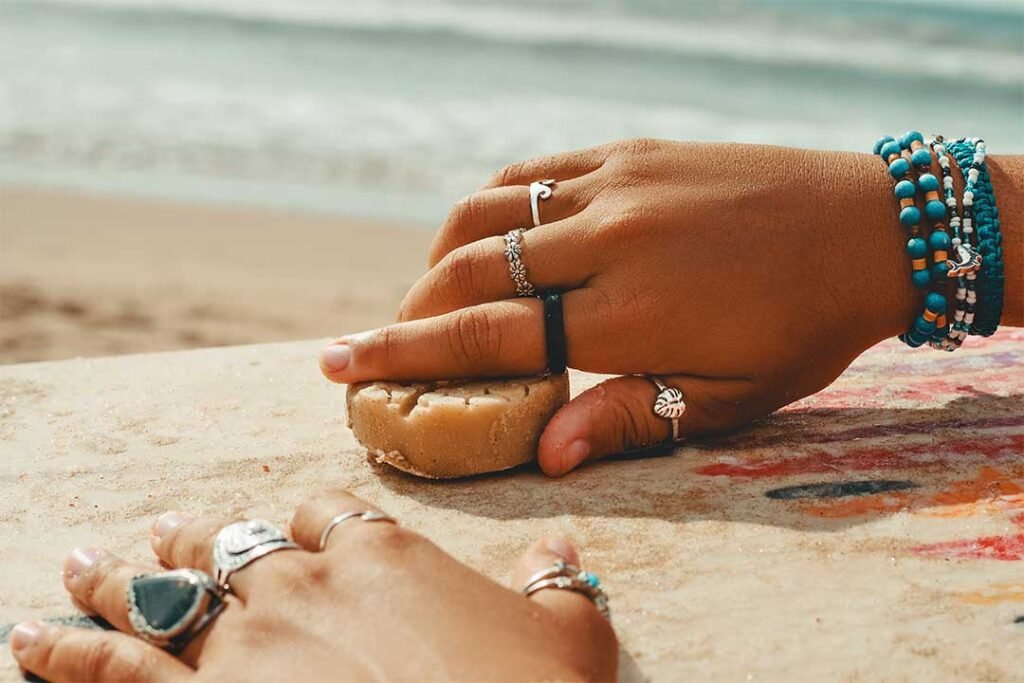As an Amazon Associate I earn from qualifying purchases.
This post contains affiliate links.
One essential aspect of maintaining your surfboard is knowing how to apply wax on a Surfboard. Proper waxing not only enhances your grip on the board but also ensures a smoother and more enjoyable surfing experience. In this guide, we’ll delve into the step-by-step process to how to apply wax on a Surfboard, providing valuable insights for surfers of all levels.

Understanding the Importance of Wax:
Before we dive into the application process, let’s explore why waxing is crucial for surfboards. The primary purpose of wax is to provide traction between your feet and the board, preventing slipping and enhancing control. It also helps to create a hydrophobic surface, allowing water to bead off the board, reducing drag, and increasing speed. Without proper waxing, your surfing performance may be compromised, and you might find it challenging to stay on the board during maneuvers.
Choosing the Right Wax:
Selecting the right wax for your surfboard is the first step towards a successful waxing session. Waxes come in different temperatures, designed to perform optimally under specific water conditions. Cold water wax is suitable for temperatures below 60°F (15°C), while warm water wax is ideal for temperatures above 60°F (15°C). Be sure to choose the appropriate wax for the water conditions you’ll be surfing in to ensure maximum effectiveness.
Step-by-Step Guide to Applying Wax on a Surfboard:
Start with a Clean Board:
Before applying wax, ensure that your surfboard is clean and free from any sand, dirt, or old wax. Use a wax comb or a plastic scraper to gently remove any residue, paying attention to the areas around the traction pad and the tail.
Base Coat Application:
Begin by applying a base coat of wax to the entire deck of the surfboard. Hold the wax at a slight angle and make long, diagonal strokes to create a crosshatch pattern. This initial layer provides a foundation for the topcoat to adhere to.
Topcoat Application:
Once the base coat is applied, it’s time to add the topcoat. Use a wax designed for the specific water temperature you’ll be surfing in. Apply the topcoat using firm, circular motions, ensuring complete coverage. Focus on the areas where your feet will be positioned, as this is where maximum traction is required.
Build Up Layers:
For optimal grip, it’s recommended to build up multiple layers of wax. Repeat the topcoat application process, adding additional layers until you achieve the desired level of stickiness. Pay attention to the wax’s texture – it should feel slightly bumpy to the touch.
Add Extra Texture for High-Performance Surfing:
If you’re an advanced surfer looking for extra grip, consider adding a layer of tropical or extra sticky wax over the existing layers. This additional texture can be especially beneficial for executing advanced maneuvers and tricks.
Tips for Maintenance and Longevity:
Regularly Check and Replace Worn-out Wax:
Keep an eye on the condition of your wax, especially after each surf session. If you notice areas where the wax has worn thin or has become smooth, it’s time for a reapplication.
Remove Old Wax Before Reapplying:
When it’s time to add a new layer of wax, make sure to remove the old wax completely. This can be done using a wax comb, a plastic scraper, or by using a commercial wax remover. A clean surface ensures better adhesion for the new wax.
Store Your Board Properly:
To prolong the life of your wax and maintain its effectiveness, store your surfboard in a cool, shaded area when not in use. Avoid exposing it to direct sunlight for extended periods, as excessive heat can cause the wax to melt and lose its grip.
Knowing how to apply wax to a surfboard is a basic skill. Every surfer should know about this. By following these step-by-step instructions and incorporating proper maintenance practices, you’ll not only enhance your surfing performance but also extend the life of your board. Remember to choose the right wax for the water temperature, build up multiple layers for optimal traction, and regularly inspect and replace worn-out wax. With these tips, you’ll be ready to hit the waves with confidence and style, enjoying the thrill of surfing to the fullest.
As an Amazon Associate I earn from qualifying purchases.
Leave a Reply